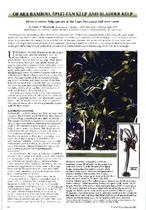| dc.contributor.author | Maneveldt, Gavin | |
| dc.contributor.author | Frans, Rene | |
| dc.date.accessioned | 2014-02-11T10:45:37Z | |
| dc.date.available | 2014-02-11T10:45:37Z | |
| dc.date.issued | 2001 | |
| dc.identifier.citation | Maneveldt, G.W. & Frans, R. (2001). Of sea bamboo, split fan kelp and bladder kelp: three common kelp species of the Cape Peninsula and West Coast. Veld & Flora 87(1): 38-39 | en_US |
| dc.identifier.issn | 0042-3203 | |
| dc.identifier.uri | http://hdl.handle.net/10566/1001 | |
| dc.description.abstract | The third part in our series on the common intertidal seaweeds of the Cape Peninsula looks at the kelps, the giant brown seaweeds that occur in the subtidal and intertidal gullies of the Cape Peninsula and the west coast. Like trees an ancient forest, kelp dominate the canopy of the subtidal zone in the cool, nutrient-rich waters of the South African west coast. Kelp is the largest and fastest growing of the seaweeds, growing as much as 13 mm in a day. Some of these seaweeds as the giant kelp (Macrocystis pyrifera) of central and southern California are known to grow to over 30 m in length. | en_US |
| dc.language.iso | en | en_US |
| dc.publisher | Botanical Society of South Africa | en_US |
| dc.rights | Copyright Botanical Society of South Africa. Permission has been given to reproduce this file in the Repository. | |
| dc.subject | Cape Peninsula | en_US |
| dc.subject | Kelp | en_US |
| dc.subject | Macrocystis pyrifera | en_US |
| dc.subject | Nutrient-rich waters | en_US |
| dc.title | Of sea bamboo, split fan kelp and bladder kelp: three common kelp species of the Cape Peninsula and West Coast | en_US |
| dc.type | Article | en_US |
| dc.privacy.showsubmitter | false | |
| dc.status.ispeerreviewed | false | |

